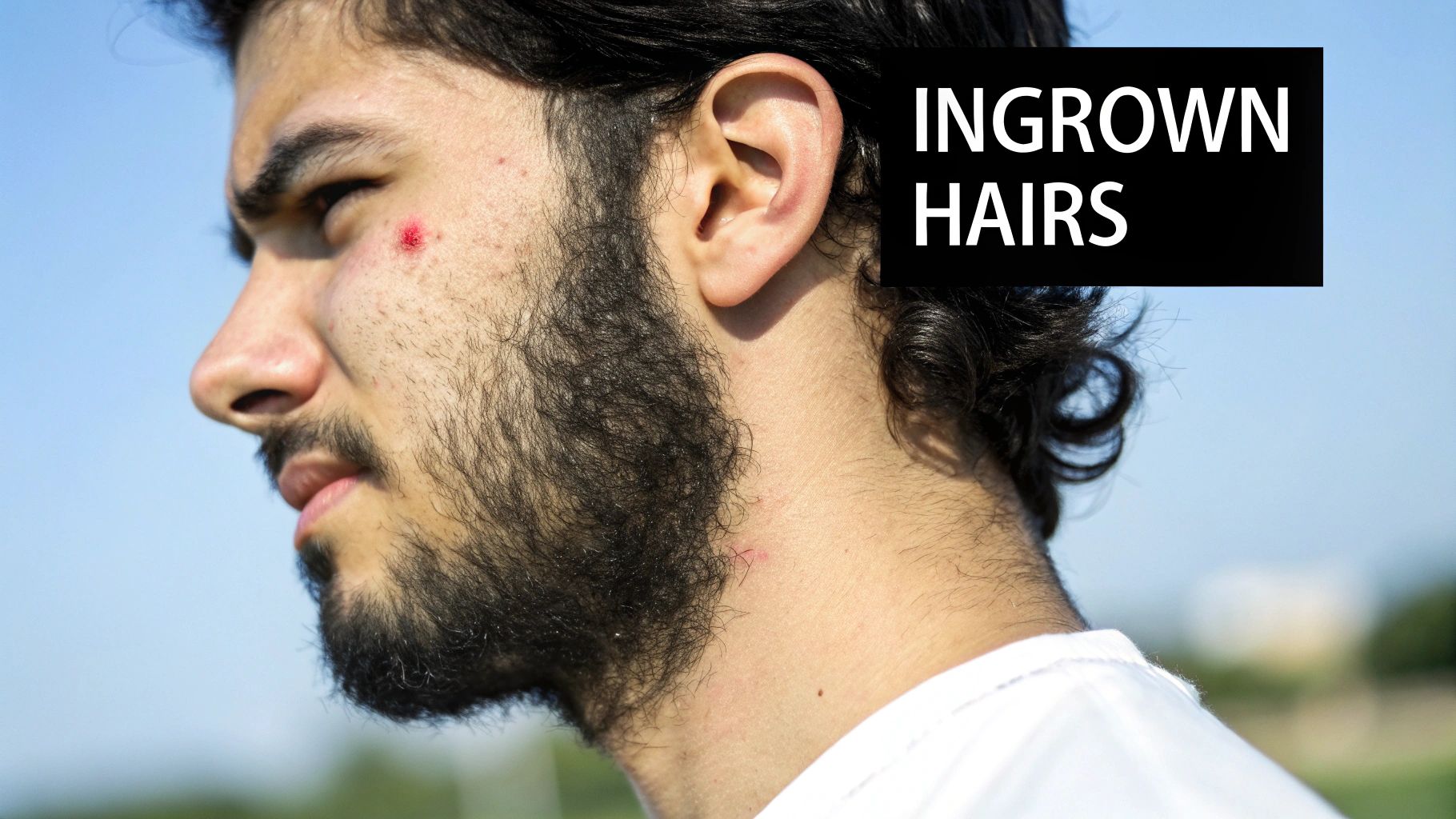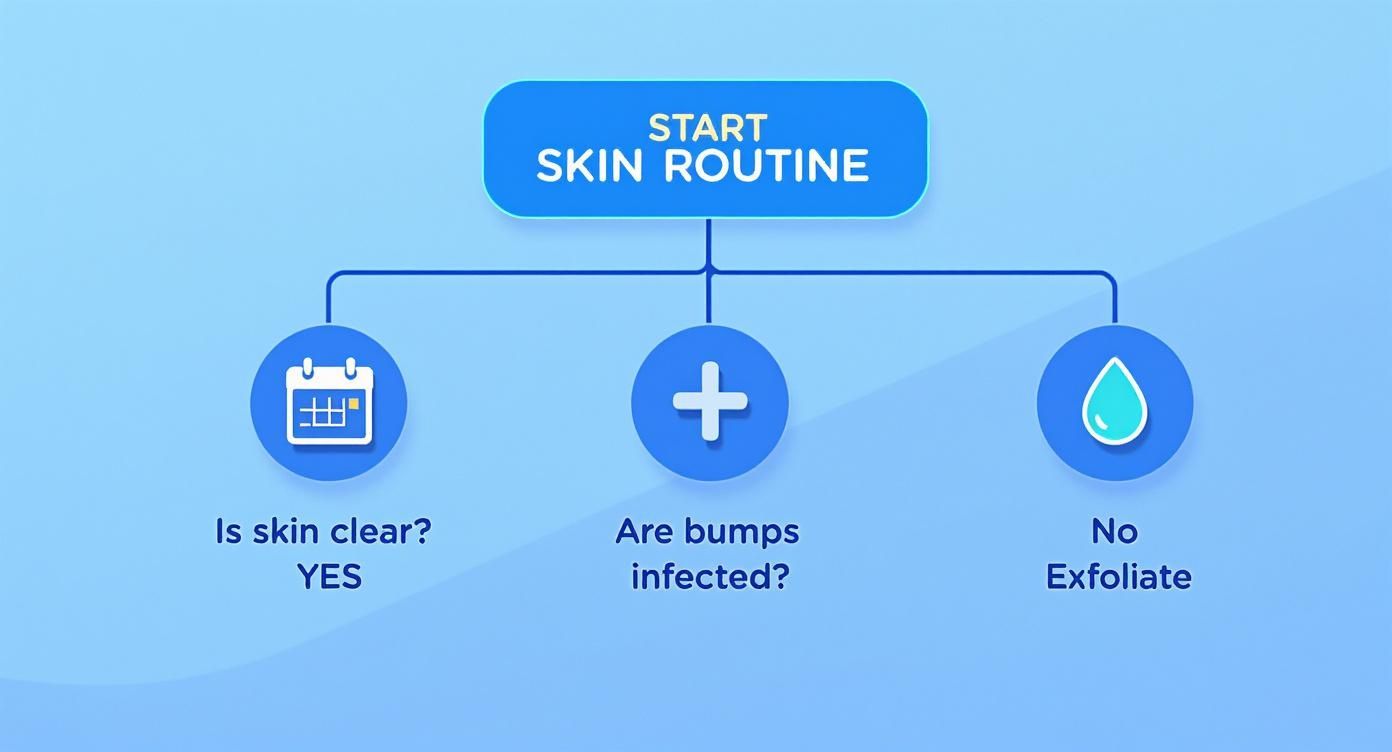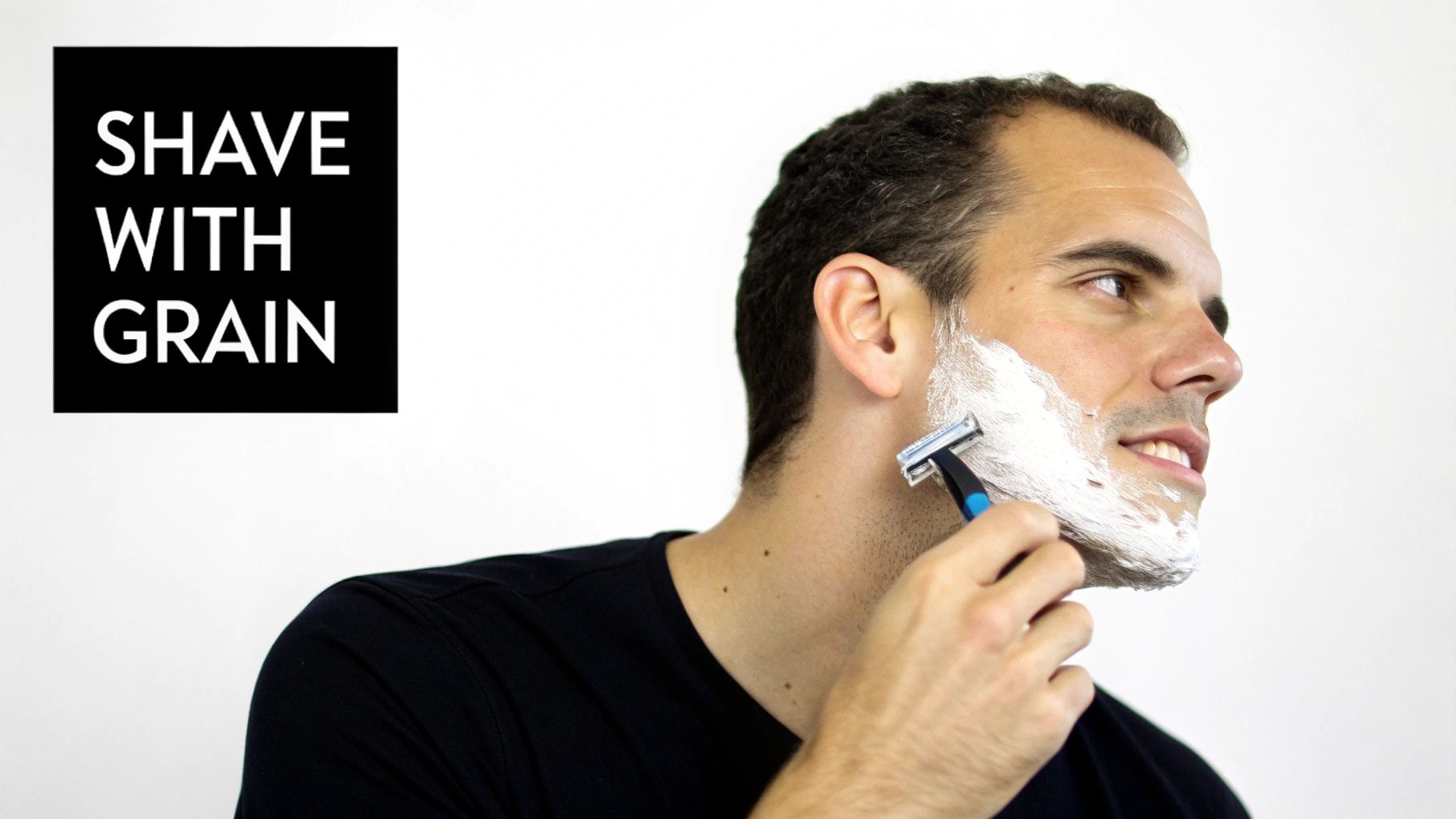Jan Elvis
29.10.2025

Jan Elvis
29.10.2025
To get rid of razor bumps for good, you first have to know your enemy. We’re not just talking about a little post-shave redness here. Razor bumps are a specific reaction that happens when sharp-tipped hairs curl back on themselves and start growing into your skin.
Once you get what’s actually happening under the surface, you can stop wasting time on quick fixes and start building a real strategy for clear, smooth skin.

The official medical term is pseudofolliculitis barbae (PFB), but you can think of it as your body's self-defense mechanism kicking into overdrive. When you shave, the razor cuts the hair, often at a sharp angle. As that hair starts to grow back, its natural curl can cause it to bend and pierce the skin from the side instead of growing straight out.
Your body sees that ingrown hair as a foreign object—like a tiny splinter—and immediately mounts an attack. It sends in white blood cells to deal with the "invader," which causes the tell-tale red, itchy, and sometimes painful bumps. They often look just like pimples and can get infected if you’re not careful.
Literally anyone can get razor bumps, but they are a massive problem for people with coarse or tightly curled hair. It’s simple physics: the hair's natural curl pattern makes it far more likely to bend back into the skin after it’s been cut short. This has everything to do with hair structure, not how clean you are.
The data backs this up in a big way. For example, in the U.S. military where being clean-shaven is policy, studies have found that PFB affects 45–83% of Black soldiers. That's a huge difference compared to their White counterparts. If you're curious about the science, this detailed study on PubMed Central breaks down the prevalence across different groups.
Key Takeaway: Razor bumps aren't acne. They're an inflammatory reaction to ingrown hairs—a physical problem caused by hair texture and how you shave.
While your hair type sets the stage, your shaving technique is what really determines whether you get bumps or not. I've seen countless people make the problem worse by falling into a few common traps.
These are the biggest culprits:
At its core, this is an inflammatory issue. A little bit of knowledge about understanding the body's inflammatory responses can really help connect the dots on why your skin is freaking out. And for more targeted advice, be sure to check out our complete guide on https://dontlooktrash.com/blogs/main-character/how-to-prevent-ingrown-hairs.

When a fresh crop of razor bumps appears, the first impulse is often to attack. We’ve all been there—wanting to pick, squeeze, or scrub them into oblivion. But trust me, that's the fastest way to make the inflammation worse and risk scarring. The right move is to be calm, targeted, and focused on soothing the skin first.
Your absolute first step? Give your skin a break. Seriously, put the razor down for at least a few days. Shaving over already inflamed bumps just grinds the blade over irritated skin, creating more trauma and spreading bacteria. This can turn a minor annoyance into a full-blown breakout. Let your skin breathe and begin its own healing process.
To take the edge off the immediate discomfort and swelling, a warm compress can be a game-changer. It’s not just a feel-good remedy; the warmth actually helps soften the skin, which can coax a trapped ingrown hair closer to the surface.
Just soak a clean washcloth in warm water (not hot!), wring it out, and press it gently against the bumps for 10-15 minutes. You can repeat this a few times throughout the day. This simple trick increases blood flow to the area, which speeds up healing and eases that tight, painful sensation.
A warm compress won't make the bumps vanish instantly, but it's a powerful first-aid step. It calms that initial fiery response and preps your skin to better absorb any treatments you apply next.
Once you’ve calmed the initial flare-up, it’s time to bring in some backup. You don't need a prescription for some of the most effective ingredients out there. Look for products with these key players on the label:
For a deeper dive into tackling irritation, our guide on how to get rid of redness has even more strategies that work perfectly with these treatments.
Applying a thin layer of one of these products right after your warm compress can make a huge difference. The key is consistency and a gentle touch.
Let's move beyond just damage control. The real secret to getting rid of razor bumps for good is building a smart, consistent skincare routine. This isn't about adding a dozen complicated steps to your morning; it's about making a few key changes that stop bumps before they even have a chance to form.
Think of it as a simple three-part strategy: daily maintenance, weekly deep cleaning, and targeted backup for when you need it. Nailing this approach means you’ll spend a lot less time stressing over irritation and more time enjoying clear, smooth skin.
Your everyday mission is simple: keep your skin clean and hydrated.
Start with a non-comedogenic cleanser. That’s just a fancy way of saying it won't clog your pores. This is non-negotiable. You have to wash away the daily buildup of sweat, oil, and dirt that can easily block hair follicles and set the stage for ingrown hairs.
Right after you cleanse (and especially after you shave), lock in moisture with a lightweight, soothing moisturizer. A quality moisturizer does more than just combat dryness; it actively works to repair your skin’s natural protective barrier. When that barrier is strong, your skin can handle the stress of shaving much better and is far less likely to become inflamed.
Expert Tip: Steer clear of any post-shave products loaded with alcohol. It might feel "clean" for a second, but it strips your skin of its natural oils, leading to severe dryness and irritation—basically a fast track to making razor bumps worse.
Once or twice a week, it's time to bring in the heavy hitters: chemical exfoliants. Forget those harsh, gritty physical scrubs that can create micro-tears on already sensitive skin. Chemical exfoliants are much gentler, working by dissolving the bonds that hold dead skin cells to the surface. This process keeps follicles clear, paving the way for hair to grow out properly instead of getting trapped.
A few powerhouse ingredients to look for are:
Adding this one step a couple of times a week is probably the single most effective preventative measure you can take. You're essentially clearing the runway for new hair growth.
Every now and then, a stubborn bump will pop up despite your best efforts. That's when you call in a spot treatment. If you have a red, angry-looking bump that feels more like a pimple, a dab of a product with benzoyl peroxide will help knock out the bacteria and calm the inflammation.
For more widespread texture issues or stubborn, recurring spots, retinol can be a great long-term solution. It dramatically speeds up cell turnover, which helps prevent dead skin cells from trapping new hairs in the first place. But a word of caution: introduce retinol slowly. Start with just once or twice a week at night, as it can be drying or irritating until your skin adjusts. Think of these as your specialist tools—use them precisely when and where they're needed, not all over, all the time.
Finding the right active ingredients can feel overwhelming, but it's all about matching the ingredient to your specific problem. Are you dealing with active inflammation, or are you trying to clear out clogged pores before they become an issue?
This table breaks down the most effective ingredients you'll find in razor bump treatments, what they do, and how to use them.
| Ingredient | Primary Function | Best For | Frequency of Use |
|---|---|---|---|
| Salicylic Acid (BHA) | Deep pore exfoliation | Oily, acne-prone skin; preventing ingrowns | 2-3 times per week |
| Glycolic Acid (AHA) | Surface exfoliation | Dry or combination skin; fading dark spots | 1-2 times per week |
| Benzoyl Peroxide | Kills acne-causing bacteria | Inflamed, infected bumps (pustules) | As a spot treatment, as needed |
| Retinol | Speeds up cell turnover | Persistent bumps, uneven texture, prevention | Start with 1-2 times per week at night |
| Niacinamide | Reduces inflammation & redness | Sensitive skin, reducing irritation, strengthening skin barrier | Daily |
Think of these ingredients as your toolkit. You probably won't need all of them at once, but knowing what each one does will help you build a routine that keeps your skin consistently clear and comfortable.
While your skincare routine is crucial, the real battle against razor bumps is won or lost with the tools that actually touch your skin. Your razor and shave cream aren't just accessories; they're your first line of defense. Investing in the right gear isn't about luxury—it's about stopping irritation before it even has a chance to start.
Most of us were taught that more blades mean a closer, better shave. But when you’re prone to bumps, the opposite is often true. Let's dig into the different tools out there to help you build a kit for calm, smooth skin.
The biggest question in shaving usually boils down to the blade count. Multi-blade cartridge razors are everywhere, but they can be a primary trigger for ingrown hairs. Their "lift-and-cut" design pulls the hair up before slicing it, often cutting it below the surface of the skin. Once the skin settles back down, that sharpened hair tip gets trapped, and you've got the perfect recipe for a razor bump.
This isn't just anecdotal. Clinical studies comparing razor types have shown a major difference in irritation levels. Right after shaving, a whopping 57.6% of cartridge razor users had visible redness. In contrast, only 40.3% of those using a single-blade safety razor showed similar irritation. The data, available in the full research about razor irritation, shows the difference was still there even five minutes later.
This visual guide gives you a quick-and-easy decision tree for handling razor bumps as they pop up.

It helps you decide whether to stick with your current routine, treat infected bumps, or focus on exfoliation based on what your skin is telling you.
Here’s a quick rundown of the most common options:
The key takeaway is simple: fewer blades often mean less irritation. A single, sharp blade that cuts hair cleanly at the surface is your best defense against ingrown hairs.
Your razor is just one piece of the puzzle. The products you pair with it can completely change your results.
First things first, it's time to ditch the aerosol foam cans. Most are loaded with drying alcohols and propellants that do absolutely nothing to protect your skin. Instead, find a high-quality, lubricating shave cream or gel. Look for formulas packed with soothing ingredients like aloe vera or shea butter. A good cream creates a slick barrier, letting the razor glide over your skin instead of dragging across it.
If you really want to level up your prep, get yourself a shave brush. A brush is a game-changer for two reasons. It whips your shave cream into a much richer, thicker lather, and more importantly, it physically lifts the hairs up and away from the skin. This primes every single hair for a clean, even cut, making it far less likely to curl back inward after the shave.

You can have all the best gear in the world, but if your technique is off, your skin will pay the price. The way you prep your face, guide the blade, and cool everything down afterward is what separates a comfortable shave from a full-blown breakout. It’s about being deliberate and gentle, not just hacking away at stubble.
One of the biggest mistakes I see is guys pressing down too hard, thinking more pressure gets them a closer shave. All that does is force the blade to cut hair below the skin line, which is the fast track to ingrown hairs. A smarter technique delivers a smooth finish without the painful aftermath. It's not just theory; one clinical study found that combining better razor tech with proper technique led to a 59.6% reduction in razor bumps over 12 weeks. You can dig into the full shaving study findings yourself.
Before that razor even thinks about touching your face, you have to set the stage. Honestly, this is probably the most important part of preventing razor bumps. Let's get one thing straight: never, ever dry shave. It’s a guaranteed ticket to irritation city.
Start by softening up your skin and hair with plenty of warm water. The easiest way to nail this is by shaving right after a hot shower. Your pores will be open, and your whiskers will be soft and pliable. If you’re just at the sink, press a warm, damp towel against your face for a solid minute or two.
Next up is pre-shave oil. A lot of guys skip this, but it’s a game-changer. It creates a slick, protective barrier that lets the razor glide smoothly instead of dragging and catching on your skin.
This is the golden rule of a bump-free shave: always shave in the direction your hair grows. When you go against the grain, you yank the hair up before cutting it. This results in a cut that's too close to the skin, leaving a sharp, angled tip that’s practically designed to get trapped and become an ingrown hair.
To do this right, you need to become a bit of an expert on your own face. Take a minute and feel your stubble. Your hair's growth pattern isn't uniform—it’ll grow downwards on your cheeks but might shoot sideways or even upwards on your neck. You have to map it out.
Shaving with the grain might not feel quite as baby-smooth at first, but it’s the single most effective way to stop ingrown hairs in their tracks. A little less closeness is a tiny price to pay for healthy, calm skin.
Remember to use light, short strokes and let the weight of the razor do the heavy lifting. And don't forget to rinse your blade under hot water after every pass to keep it clean and efficient. For a complete play-by-play, check out our guide on how to shave without irritation.
What you do after the blade is put away is just as important as the shave itself. Your skin is raw and vulnerable at this point, and it’s crying out for some TLC.
First, rinse your face with cool water. This helps close up your pores and calms down any immediate redness or inflammation. Gently pat your skin dry with a clean, soft towel—no aggressive rubbing.
Finally, and this is non-negotiable, apply a high-quality, alcohol-free aftershave balm or moisturizer. This step rehydrates your skin, soothes redness, and restores its natural protective barrier. Think of it as locking in moisture and locking out the bacteria that can cause trouble later.
Even with a solid plan, you're bound to have questions. When you're dealing with the frustration of razor bumps, getting straight answers can be the difference between giving up and finally getting clear skin. Let's clear up some of the most common questions I hear.
This is the big one, and the honest answer is, it really depends on your skin and the severity of the bumps.
For a minor case, you'll likely see things calm down within a few days to a week. The key is to stop shaving the area immediately and start applying soothing, anti-inflammatory treatments. But if you're dealing with more severe or infected bumps, you might be looking at a healing time of two weeks or more.
Consistency is everything. If you stick with a good prevention routine, you should see a real, lasting change in your skin's clarity and smoothness within 4-6 weeks. That's enough time for your skin to go through a full healing cycle and for your new habits to start paying off.
I get it—the urge to grab tweezers and dig out a trapped hair is almost irresistible. But please, step away from the mirror. Digging at your skin is a one-way ticket to more inflammation, a potential infection, or even a permanent dark spot.
Now, there is one small exception. If you can clearly see the hair looped just under the surface, you can intervene very carefully. Use a sterilized needle or pointed tweezers to gently lift the hair's tip out from under the skin.
Key Takeaway: Your goal is just to free the trapped hair, not to pluck it out completely. Ripping the hair out just starts the cycle over, and the next hair that grows in will probably just get trapped again.
Yes, absolutely. If you've tried everything and are still struggling with chronic, painful bumps, there are more permanent options to consider. For many, laser hair removal is the most effective long-term solution.
Laser treatments use concentrated light to destroy the hair follicle itself, which stops the hair from growing back and causing irritation. It's especially effective for people with dark, coarse hair. Prescription creams that slow hair growth are another avenue to explore with a doctor.
When over-the-counter products just aren't cutting it, it’s time to talk to a professional. An online doctor prescription consultation is a great, convenient first step to see if these more advanced treatments are right for you. A dermatologist can give you a personalized recommendation and get you on the right track.
At Main Character, we know that taking control of your skin is about more than just looking good—it’s about feeling confident. Our products are made to help you get clear, comfortable skin, day in and day out. Explore our collection and start building your ultimate grooming routine today.